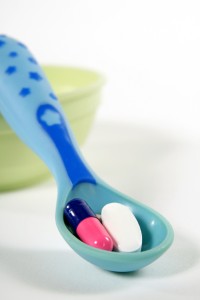There’s nothing like a sick kid to make a parent desperate, willing to spend a lot of money on any medication that might help. Before you open your wallet for over-the-counter medications, check out these 12 money-saving tips. I’ll bet you walk out of the store a bit richer.
 Learn the lingo so you can buy generic: Brand name medications almost always have a store-brand equivalent that will be significantly cheaper, but you have to know the generic name of the medication you are buying. For example, the generic name of Tylenol is acetaminophen, Advil and Motrin are the same thing as ibuprofen, Benadryl is diphenhydramine, and Zyrtec is cetirizine. A quick internet search of the brand name you are looking for will give you the generic name. Then find the generic on the shelf, usually right next to the brand name. You’ll usually save 20-50%.
Learn the lingo so you can buy generic: Brand name medications almost always have a store-brand equivalent that will be significantly cheaper, but you have to know the generic name of the medication you are buying. For example, the generic name of Tylenol is acetaminophen, Advil and Motrin are the same thing as ibuprofen, Benadryl is diphenhydramine, and Zyrtec is cetirizine. A quick internet search of the brand name you are looking for will give you the generic name. Then find the generic on the shelf, usually right next to the brand name. You’ll usually save 20-50%.- Like brand-name medications? Go to the manufacturer’s web site and get coupons before you head to the store. Or just use your phone to get the coupon while you are in the store. Brand name medications like Zyrtec, Allegra, Tylenol and Advil usually have an official site that offers coupons and savings clubs.
- Get a pill cutter: Pediatric doses are often just half of an adult dose, and it is often much cheaper to buy a box of adult tablets and cut them in half than to buy the equivalent number of pediatric tablets. For example, children’s 30 mg Allegra tablets are available on Amazon.com for about $0.90 per tablet, or you can buy generic 60 mg fexofenadine hydrocloride for about $0.35 per tablet, then cut them in half for a cost of about $0.17 per 30 mg dose. Please note that extended release tablets should not be cut. If in doubt about the safety of cutting a tablet, call your pediatrician. Click here to check age-appropriate dosages for acetaminophen (Tylenol), ibuprofen (Advil or Motrin), diphenhydramine (Benadryl), and cetirizine (Zyrtec).
- Avoid over-the-counter cough and cold medications for kids: The American Academy of Pediatrics does not recommend over-the-counter cough and cold medications for children under 4 years of age, so save your money and just don’t buy them. The AAP writes, “Research has shown these products offer little benefit to young children – and can have potentially serious side effects. Many cough and cold products for children have more than one ingredient, increasing the chance of accidental overdose if combined with another product. So without these over-the-counter cough and cold medicines, what’s the best way to treat your toddler’s cold? Acetaminophen or ibuprofen can reduce aches and pains and a cool mist vaporizer can help loosen congestion. A simple bulb syringe and saline nasal spray can be used to clear stuffy noses. Plenty of liquids, especially chicken soup, and rest also help children feel better. But don’t underestimate the power of TLC. Your caring and comfort is one of the best medicines for your child.
- Teach your kids to swallow pills: Is your 8-year-old still drinking children’s liquid medications? Time to buy some small candies and practice swallowing pills whole. Pills are usually much cheaper than liquid medications, especially if you have an older child who is drinking large quantities of liquid medications. One dose of liquid Children’s Advil for a 65 pound child will cost about $1.30. The same dose with generic tablets will cost about $0.03-$0.04.
- Get a prescription: Most over-the-counter medications are also available by prescription. Your prescription co-pay may be less than the cost of buying the drug over-the counter, especially if you take advantage of 90 day mail-order prescriptions.
- Call your pediatrician: Does your child even need the meds you are giving them? Give your pediatrician a quick call before you shell out big bucks for over-the-counter meds. Your doctor may have a better (and cheaper) plan. Do you need a pediatrician? Call 314.454.KIDS (5437) to find a St. Louis area pediatrician that is right for your family.
- Figure out your company’s flex spending plan or health savings account: Most over-the-counter medications can be purchased with money from health care flex spending accounts and health savings accounts. If you pay for your over-the-counter meds with pre-tax dollars you won’t have to pay taxes on that money.
- Buy in bulk and share/sell the extra: Big box stores like Sams Club and Costco have some of the best prices on over-the-counter medications and dietary supplements, but you have to buy them in bulk. Their prices are often lower than Walmart and Target. If you don’t need to buy large volumes, consider selling the rest. For example, buy a large bottle of ibuprofen and then sell half of it to a friend or relative. You will both save!
- Join the Walgreens Prescription Savings Club: For $35 per family per year (or $20 per individual) you get 10% off all Walgreens brand products, including over-the-counter meds. Additionally, get significant savings on prescription medications and other services. Here’s the best part– your PETS count as family members and can be added to your plan.
- Consider Amazon.com: Amazon’s “subscribe and save” program offers deep discounts for over-the-counter medications and supplements if you agree to have them automatically shipped to you at a time interval of your choice.
- Ask for a free sample: Doctors’ offices usually have free samples of common medications like ibuprofen, but you may not get them unless you ask.
Have you found another way to save money on meds? Tell us! Please use the comments section below.





Comments